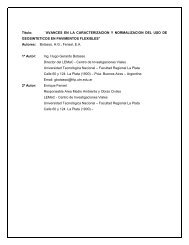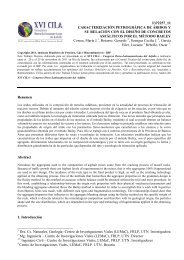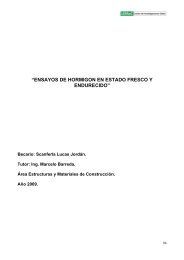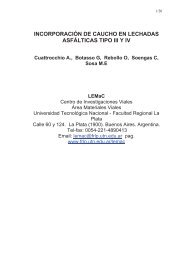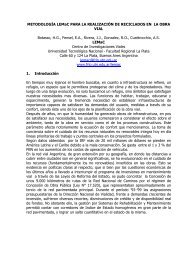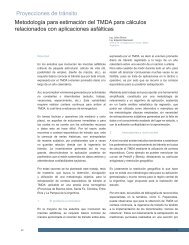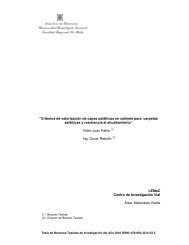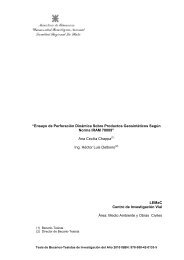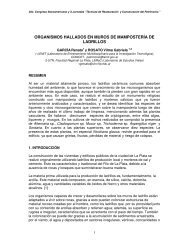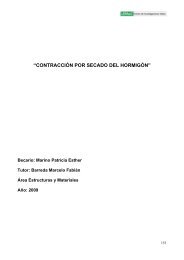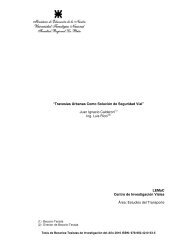Biofouling of crypts of historical and architectural interest at La Plata ...
Biofouling of crypts of historical and architectural interest at La Plata ...
Biofouling of crypts of historical and architectural interest at La Plata ...
Create successful ePaper yourself
Turn your PDF publications into a flip-book with our unique Google optimized e-Paper software.
342 P.S. Guiamet et al. / Journal <strong>of</strong> Cultural Heritage 13 (2012) 339–344<br />
Table 1<br />
Microorganisms found in various <strong>crypts</strong> <strong>at</strong> <strong>La</strong> Pl<strong>at</strong>a Cemetery (Argentina).<br />
Sample M<strong>at</strong>erial Lichens<br />
Absence/Presence<br />
Fungi<br />
CFU/cm 2<br />
Total aerobic bacteria<br />
CFU/cm 2<br />
Acid-forming bacteria<br />
CFU/cm 2<br />
Crypt C95 (marble column) Marble Presence 40 × 102 40 × 102 10 × 102 Crypt C77 (marble flower pot, internal side) Marble Presence 50 × 102 14 × 103 No growth<br />
Crypt F87 (door) Cement mortar Presence 10 × 103 70 × 106 10 × 105 Crypt A9 (front) Cement mortar Presence 60 × 102 31 × 103 35 × 104 Crypt A9 (side wall) Cement mortar Presence 50 × 103 32 × 103 35 × 104 L’Epine (a calcareous monument in Marne, France). The presence <strong>of</strong><br />
these species indic<strong>at</strong>ed th<strong>at</strong> nutrient enrichment <strong>of</strong> the stone substr<strong>at</strong>e<br />
had favored the lichens’ growth. Overall, the recent increase<br />
in lichen coloniz<strong>at</strong>ion may be rel<strong>at</strong>ed to the widespread use <strong>of</strong> fertilizers<br />
<strong>and</strong> above all to the newly implemented method <strong>of</strong> spraying<br />
by pulveriz<strong>at</strong>ion. This was reflected by the broader extent <strong>of</strong> lichen<br />
popul<strong>at</strong>ions, augmenting the disfigurement on the west-facing surfaces,<br />
which are more exposed to the dominant winds.<br />
Bech-Andersen <strong>and</strong> Christensen [13] observed th<strong>at</strong> in cementbased<br />
m<strong>at</strong>erials the cement paste was preferentially <strong>at</strong>tacked by<br />
lichens, leaving the aggreg<strong>at</strong>es unaffected. More recent studies<br />
showed th<strong>at</strong> Caloplaca austrocitrina can penetr<strong>at</strong>e both cement <strong>and</strong><br />
concrete. This species also produces oxalic acid, whose chemical<br />
action causes a loss <strong>of</strong> calcium from mortar substr<strong>at</strong>es [14]. In a<br />
study <strong>of</strong> stone monuments in Rome, Seward [15] described the differential<br />
actions <strong>of</strong> lichen species in biodeterior<strong>at</strong>ion. Furthermore,<br />
not all species are harmful. While the sporadic growth <strong>of</strong> Lecanora<br />
muralis has been rel<strong>at</strong>ed to the mechanical decay <strong>of</strong> the substr<strong>at</strong>e,<br />
species such as Lecanora dispersa, which also account for significant<br />
coverage, do not cause evident modific<strong>at</strong>ions. Monte [16] observed<br />
th<strong>at</strong> Lecanora campestris <strong>and</strong> Lecanora rupicola preferentially grow<br />
on W to SW exposures whereas Xanthoria calcicola grows mainly<br />
on south-facing surfaces. These preferences are consistent with<br />
the fact th<strong>at</strong> some species are stenoic, thriving only within a very<br />
specific range <strong>of</strong> pH, humidity, luminosity, <strong>and</strong> nitrogen supply,<br />
while others are euroic <strong>and</strong> thus tolerant <strong>of</strong> a wider range <strong>of</strong> conditions<br />
[17]. Although their role as primary colonizer seems doubtful,<br />
lichens nonetheless cause reduced substr<strong>at</strong>e cohesion <strong>and</strong> therefore<br />
biocorrosion. In the <strong>crypts</strong> sampled in the present study, the<br />
surfaces were rough, eroded, <strong>and</strong> uneven due to the chemically<br />
targeted destruction <strong>of</strong> the cement m<strong>at</strong>rix but not the aggreg<strong>at</strong>es,<br />
which were unaffected. Mechanical damage, by contrast, results<br />
from penetr<strong>at</strong>ion <strong>of</strong> the substr<strong>at</strong>e by lichen hyphae. The penetr<strong>at</strong>ion<br />
depth <strong>of</strong> the thallus depends on the lichen species <strong>and</strong> the n<strong>at</strong>ure <strong>of</strong><br />
the substr<strong>at</strong>e [18]. Lichens may also cause substr<strong>at</strong>e damage by the<br />
production <strong>of</strong> acidic substances, such as carbon dioxide, lichenic<br />
acids, <strong>and</strong> oxalic acid. A full review <strong>of</strong> lichens as agents <strong>of</strong> damage<br />
can be found in Lisci et al. [17].<br />
While chemolithotrophic microorganisms have <strong>of</strong>ten been<br />
described in associ<strong>at</strong>ion with damaged inorganic m<strong>at</strong>erials, more<br />
recent studies have emphasized the significance <strong>of</strong> chemoorganotrophic<br />
bacteria <strong>and</strong> fungi, together with photoautotrophs, as<br />
the primary colonizers <strong>of</strong> building stones. The activities <strong>of</strong><br />
these primary colonizers precondition the building for <strong>at</strong>tack by<br />
chemolithoautotrophs <strong>and</strong> thus initi<strong>at</strong>e the process <strong>of</strong> biological<br />
succession [19].<br />
3.3. Fungi<br />
Aspergillus sp. <strong>and</strong> Penicillium sp. were the predominant groups<br />
probably because they are ubiquitous air-borne fungi <strong>and</strong> easily<br />
cultivable. Fusarium sp., C<strong>and</strong>ida sp., <strong>and</strong> Rhodotorula sp. were also<br />
detected among the fungi th<strong>at</strong> colonized <strong>La</strong> Pl<strong>at</strong>a Cemetery’s marble<br />
<strong>and</strong> cement mortar <strong>crypts</strong>. The fungal-medi<strong>at</strong>ed deterior<strong>at</strong>ion<br />
<strong>of</strong> stone was previously reviewed by May et al. [20]. Fungi were<br />
also identified by Wollenzein et al. [21] as the caus<strong>at</strong>ive agents <strong>of</strong><br />
the deterior<strong>at</strong>ion <strong>of</strong> marble <strong>and</strong> other calcareous m<strong>at</strong>erials used<br />
in the building <strong>of</strong> culturally important monuments in many localities<br />
in the Mediterranean area. Gaylarde <strong>and</strong> Gaylarde [22], in a<br />
compar<strong>at</strong>ive study <strong>of</strong> the microbial biomass <strong>of</strong> bi<strong>of</strong>ilms occurring<br />
on the exteriors <strong>of</strong> buildings in Europe <strong>and</strong> L<strong>at</strong>in America, found<br />
th<strong>at</strong> fungi, although not an important contributor to the biomass<br />
invading stone, seemed to preferentially colonize painted surfaces<br />
r<strong>at</strong>her than other substr<strong>at</strong>es (cement, mortar, concrete). Perfettini<br />
et al. [23] isol<strong>at</strong>ed a strain <strong>of</strong> Aspergillus th<strong>at</strong> produced gluconic <strong>and</strong><br />
oxalic acids during the degrad<strong>at</strong>ion <strong>of</strong> cement. After 8 months <strong>of</strong><br />
contact with the substr<strong>at</strong>e, these acids had induced the dissolution<br />
<strong>of</strong> portl<strong>and</strong>ite (without the leaching <strong>of</strong> calcium) <strong>and</strong> had increased<br />
the porosity <strong>of</strong> the cement while reducing its bending strength.<br />
In more recent labor<strong>at</strong>ory studies, ordinary Portl<strong>and</strong> cement<br />
pastes were severely <strong>at</strong>tacked during bioleaching using Aspergillus<br />
niger cultures, especially by fungal biogenic organic (acetic, butyric,<br />
lactic, <strong>and</strong> oxalic) acids <strong>and</strong> to a lesser extent by respir<strong>at</strong>ioninduced<br />
carbonic acid [24]. However, this study was conducted<br />
under <strong>at</strong>ypical conditions, in which large amounts <strong>of</strong> w<strong>at</strong>er were<br />
present, <strong>and</strong> cannot be rel<strong>at</strong>ed to the conditions to which most<br />
buildings are exposed.<br />
The turgor pressure exerted by the hyphae <strong>of</strong> plant p<strong>at</strong>hogens<br />
such as the rice blast fungus Magnaporthe grisea has been calcul<strong>at</strong>ed<br />
on synthetic surfaces, including the plastic poly(vinyl chloride)<br />
[25]. Indirect measurement <strong>of</strong> turgor pressure indic<strong>at</strong>ed th<strong>at</strong> the<br />
hyphae <strong>of</strong> this fungus can gener<strong>at</strong>e pressures in excess <strong>of</strong> 8.0 MPa,<br />
which is sufficient to allow fungal penetr<strong>at</strong>ion <strong>of</strong> marble (tension<br />
resistance <strong>of</strong> 3.9 MPa), thereby causing mechanical damage <strong>at</strong> the<br />
ultrastructural level.<br />
3.4. Bacteria<br />
Total aerobic bacteria <strong>and</strong> acid-forming bacteria counts are<br />
shown in Table 1. Based on these counts, cement mortar was<br />
more highly colonized than marble. From the isol<strong>at</strong>ed bacteria,<br />
three isol<strong>at</strong>es were selected for sequencing based on<br />
the Gram staining <strong>and</strong> API results. These bacteria were subsequently<br />
identified as Bacillus sp. <strong>and</strong> Pseudomonas sp. Their<br />
sequences were deposited in GenBank under the accession numbers<br />
JN837477 (97% similarity with JN208185), JN837478 (98%<br />
similarity with HM352366), <strong>and</strong> JN837479 (96% similarity with<br />
AY269246). Bacillus sp. (spore-forming bacteria) <strong>and</strong> Pseudomonas<br />
sp. (desicc<strong>at</strong>ion-tolerant bacteria) are able to survive in nonfavorable<br />
conditions <strong>and</strong> can be easily found in environmental<br />
samples.<br />
Heterotrophic bacteria have frequently been isol<strong>at</strong>ed on stone<br />
monuments <strong>and</strong> are known to cause biodeterior<strong>at</strong>ion [26]. Flores<br />
et al. [27] found several species <strong>of</strong> the genera Bacillus on we<strong>at</strong>hered<br />
s<strong>and</strong>stones <strong>of</strong> a church. Vuorinen et al. [28] observed th<strong>at</strong> Finnish<br />
granite is slowly degraded by cultures <strong>of</strong> Pseudomonas aeruginosa,<br />
resulting in morphological alter<strong>at</strong>ion <strong>of</strong> the stone surface <strong>and</strong> the<br />
elution <strong>of</strong> minerals from the stone.<br />
In the <strong>crypts</strong> examined in this study, acid-forming bacteria<br />
were isol<strong>at</strong>ed from marble <strong>and</strong> from cement mortar. These bacteria




